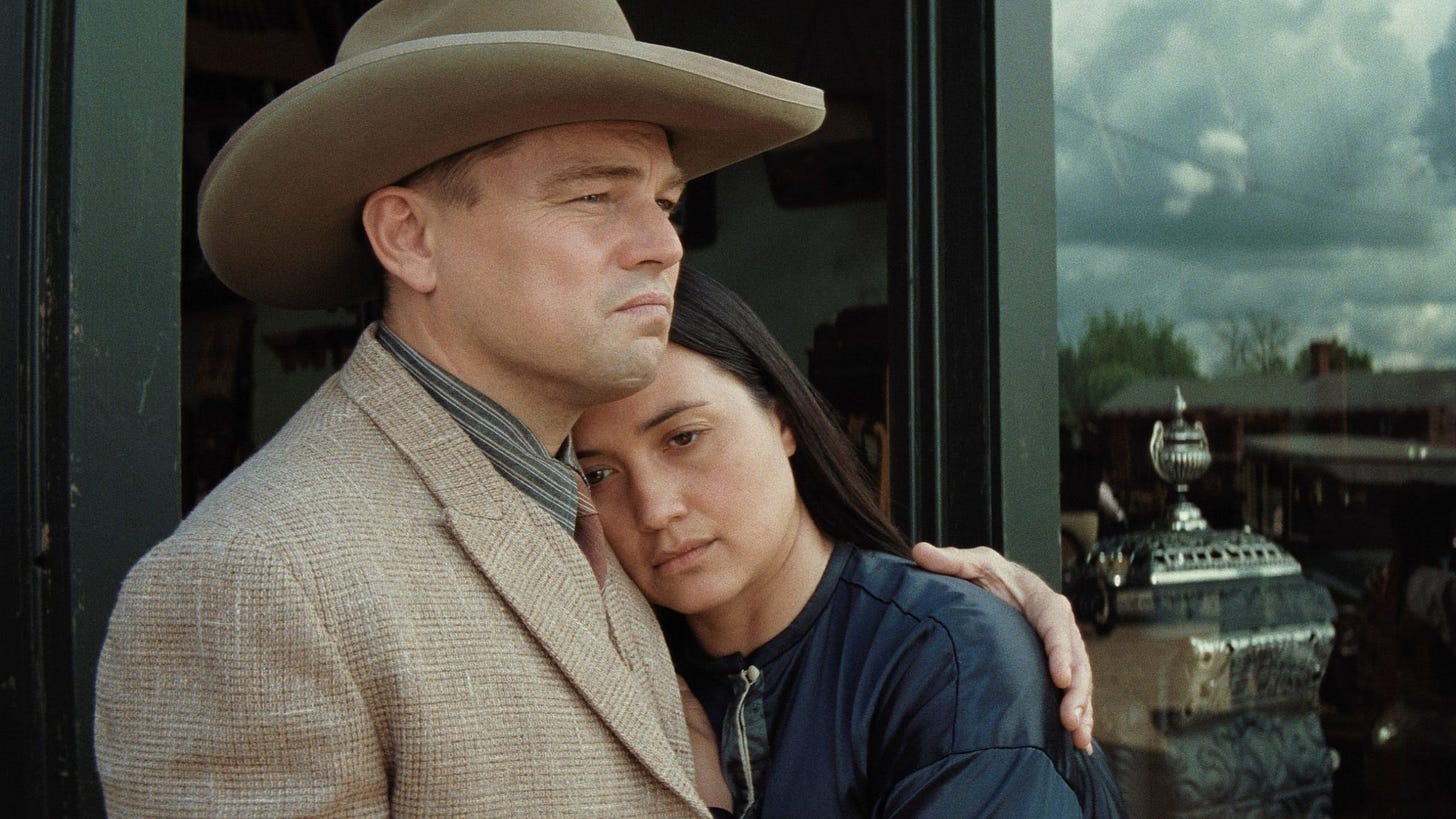“The storm is powerful, so we need to be quiet for a while.”
Far from a tempest in a teapot, Martin Scorsese’s long-in-the-making Killers of the Flower Moon is a true epic — and not just because it clocks in at three hours and twenty-six minutes. Far more has been written about that runtime than ever needed to be, so know this: if you check your watch even once, it’ll most likely be out of hope that you aren’t approaching the end. And yet, by the time the credits eventually roll on this true-crime tragedy, you might also find yourself wishing the narrative had centered around its most compelling character rather than the two men working in concert to take what’s rightfully hers.
That the film marks Scorsese’s first simultaneous collaboration with his two most prolific leading men is sure to lure many a viewer to the theater (and, perhaps more to the point, to Apple TV+), but it isn’t Leonardo DiCaprio or Robert De Niro you’ll be thinking about when you return to the real world 206 minutes later. That would be Lily Gladstone, here playing an Osage woman named Mollie Burkhart (née Kyle) in 1920s Oklahoma who, along with the rest of her Nation, is exorbitantly rich following the discovery of oil on their ostensibly worthless reservation. Wealth comes at a cost, especially when those who acquire it are deemed unworthy by the powers that be — and those powers go wholly unchecked here, at least for a time. Killers of the Flower Moon is an adaptation of David Grann’s nonfiction bestseller of the same name, the subtitle of which gives an indication as to where all this is headed: The Osage Murders and the Birth of the FBI.
Gladstone is a uniquely commanding screen presence, one who first endeared herself to cinephiles by delivering the most moving performance in a film starring Michelle Williams, Laura Dern, and Kristen Stewart; repeating that feat alongside DiCaprio and De Niro is even more impressive. (Though billed third, she’s first in our hearts.) DiCaprio plays her war-hero husband Ernest, who’s brought into the fold by his wealthy, plotting uncle (De Niro). It’s an expectedly great performance, but the same qualities that make Ernest an effective patsy also make him a less-than-compelling protagonist: not actively malicious but passively compliant in his paterfamilias’ avaricious scheme, his true feelings buried beneath an aw-shucks charm.
Nothing either man says or does is nearly as intriguing as the mere sight of Gladstone’s visage, which is so naturally expressive it would make Norma Desmond proud. There’s a quiet authority to her voice and a well of emotion behind her eyes, the edges of which grow wearier as diabetes and multiple deaths in the family take their toll. Your own gaze is fixed on her whenever she’s onscreen, and when she isn’t you’ll find yourself wishing she were. Afflicted with the same “wasting disease” as her mother and one of her sisters, Mollie is betrayed by her body and her would-be protector alike. Killers of the Flower Moon does eventually bring its focus back to her, with Scorsese intervening more directly than you might imagine, in a coda so effective you can’t help wishing it were the rule rather than the exception.
“The Osage are the finest, wealthiest, and most beautiful people on God’s earth,” De Niro’s patriarch of the plains says early on. Whether or not he believes it is a matter of debate, given his actions, but Killers of the Flower Moon certainly seems to. The film is at its best both visually and narratively when highlighting their rituals and ceremonies, whether mournful or celebratory. In addition to consulting with Osage leaders throughout production, Scorsese reworked the script so it wasn’t “about all the white guys.” Though commendable, it still feels like a half measure. The white guys remain the focus, and their perspective simply isn’t as interesting as Mollie’s would have been — not least because it saps what might have been a murder mystery of its actual mystery.
While reading aloud from an illustrated history of the Osage given to him by his uncle, Ernest asks whether we can “find the wolves in this picture.” The answer is a resounding yes, despite the fact that several of them — him very much included — disguise themselves in sheep’s clothing. It’s an engrossing task, even if it sometimes comes at the expense of the actual sheep more worthy of our attention.







Great review and really cannot wait!
I loved her performance and I wish she had won the Oscar over Emma Stone, though I do understand how Stone won. But yes, Gladstone has such a wonderfully expressive face for acting and that scream… I can still hear that scream.
Loved the Norma Desmond line haha